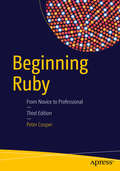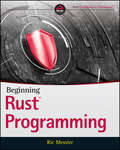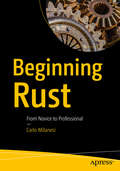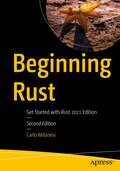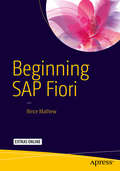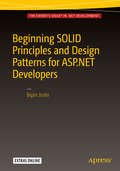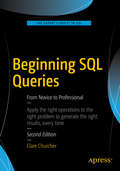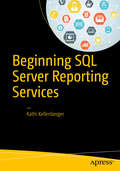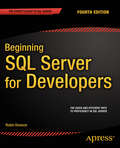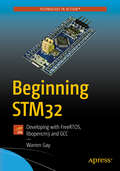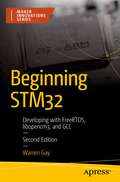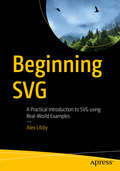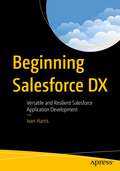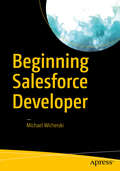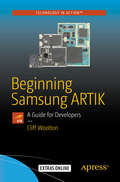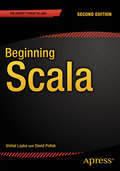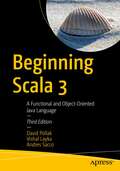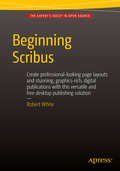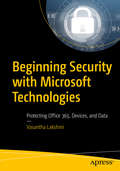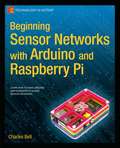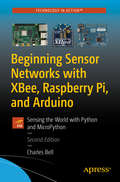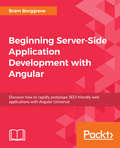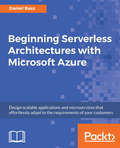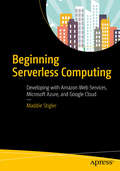- Table View
- List View
Beginning Ruby: From Novice to Professional
by Peter CooperBased on the bestselling first edition, Beginning Ruby: From Novice to Professional, Second Edition is the leading guide for every type of reader who wants to learn Ruby from the ground up. The new edition of this book provides the same excellent introduction to Ruby as the first edition plus updates for the newest version of Ruby, including the addition of the Sinatra and Ramaze web application frameworks and a chapter on GUI development so developers can take advantage of these new trends. Beginning Ruby starts by explaining the principles behind object-oriented programming and within a few chapters builds toward creating a full Ruby application. By the end of the book, in addition to in-depth knowledge of Ruby, you'll also have basic understanding of many ancillary technologies such as SQL, XML, web frameworks, and networking. Introduces readers to the Ruby programming language Takes readers from basic programming skills to web development with topics like Ruby-based frameworks and GUI programming Covers many ancillary technologies in order to provide a broader picture (e. g. , databases, XML, network daemons) What you'll learn Understand the basics of Ruby and object-oriented building blocks. Work with Ruby libraries, gems, and documentation. Work with files and databases. Write and deploy Ruby applications. Explore Ruby web frameworks and aspects of network programming with Ruby. Develop desktop and GUI applications with Ruby. Who this book is for Beginning programmers, programmers new to Ruby, and web developers interested in knowing the foundations of the language. Table of Contents Let's Get It Started: Installing Ruby Programming = Joy: A Whistle-Stop Tour of Ruby and Object Orientation Ruby's Building Blocks: Data, Expressions, and Flow Control Developing Your First Ruby Application The Ruby Ecosystem Classes, Objects, and Modules Projects and Libraries Documentation, Error Handling, Debugging, and Testing Files and Databases Deploying Ruby Applications and Libraries Advanced Ruby Features Tying It Together: Developing a Larger Ruby Application Web Application Frameworks: Rails, Sinatra, and Ramaze Ruby and the Internet Networking, Sockets, and Daemons GUI-Based Desktop Application Development Useful Ruby Libraries and Gems
Beginning Rust Programming
by Ric MessierThis is not your typical programming book! Jump right in with interesting, useful programs, some of which are drawn from classic computer science problems as a way of talking about the programming constructs in the language rather than explaining everything in a dry, theoretical manner that doesn’t translate well to implementation.Rust programming has been the "most loved programming language" in the Stack Overflow Developer Survey every year since 2016! Learn why programmers are using Rust due to it's performance and efficency, without the errors and crashes that a programmer would find in common languages such as C and C++. Built around solving real problems, this book will help introduce you to computer science problems that can be built upon to create solutions for other problems. LEARN BY DOING: This book will focus on a practical approach to learing Rust. You will learn all of the language fundamentals through the use of programming examples that do interesting things! All of the programs covered will be based on a computer science problem or othre interesting problems that can be used as a foundation for demonstrating language syntax, data types and structures, and other features or techniques for developing programs.
Beginning Rust: From Novice To Professional
by Carlo MilanesiLearn to program with Rust in an easy, step-by-step manner on Unix, Linux shell, macOS and the Windows command line. As you read this book, you’ll build on the knowledge you gained in previous chapters and see what Rust has to offer. Beginning Rust starts with the basics of Rust, including how to name objects, control execution flow, and handle primitive types. You’ll see how to do arithmetic, allocate memory, use iterators, and handle input/output. Once you have mastered these core skills, you’ll work on handling errors and using the object-oriented features of Rust to build robust Rust applications in no time.Only a basic knowledge of programming is required, preferably in C or C++. To understand this book, it's enough to know what integers and floating-point numbers are, and to distinguish identifiers from string literals.After reading this book, you'll be ready to build Rust applications. What You'll LearnGet started programming with RustUnderstand heterogeneous data structures and data sequencesDefine functions, generic functions, structs, and moreWork with closures, changeable strings, ranges and slicesUse traits and learn about lifetimes Who This Book Is For Those who are new to Rust and who have at least some prior experience with programming in general: some C/C++ is recommended particularly.
Beginning Rust: Get Started with Rust 2021 Edition
by Carlo MilanesiLearn to program with Rust 2021 Edition, in an easy, step-by-step manner on Unix, the Linux shell, macOS, and the Windows command line. As you read this book, you’ll build on the knowledge you gained in previous chapters and see what Rust has to offer. Beginning Rust starts with the basics of Rust, including how to name objects, control execution flow, and handle primitive types. You’ll see how to do arithmetic, allocate memory, use iterators, and handle input/output. Once you have mastered these core skills, you’ll work on handling errors and using the object-oriented features of Rust to build robust Rust applications in no time. Only a basic knowledge of programming in C or C++ and familiarity with a command console are required. After reading this book, you’ll be ready to build simple Rust applications. What You Will Learn Get started programming with Rust Understand heterogeneous data structures and data sequences Define functions, generic functions, structs, and more Work with closures, changeable strings, ranges and slices Use traits and learn about lifetimes Who This Book Is For Those who are new to Rust and who have at least some prior experience with programming in general: some C/C++ is recommended particularly.
Beginning SAP Fiori
by Bince MathewTake a deep dive into SAP Fiori and discover Fiori architecture, Fiori landscape installation, Fiori standard applications, Fiori Launchpad configuration, tools for developing Fiori applications and extending standard Fiori applications. You will learn: Fiori architecture and its applications Setting up a Fiori landscape and Fiori Launchpad Configuring, customizing and enhancing standard Fiori applications Developing Fiori native applications for mobile Internet of Things-based custom Fiori applications with the HANA cloud platform Bince Mathew, a SAP mobility expert working for an MNC in Germany, shows you how SAP Fiori, based on HTML5 technology, addresses the most widely and frequently used SAP transactions like purchase order approvals, sales order creation, information lookup, and self-service tasks. This set of HTML5 apps provides a very simple and accessible experience across desktops, tablets, and smartphones. What you'll learn Prerequisites and steps for setting up a Fiori landscape and Launchpad Fiori standard application configuration Extending and customizing standard Fiori applications Developing custom Fiori applications from scratch Building custom Fiori applications for Internet Of Things using HANA cloud Fiori apps with Cordova and Kapsel plugins Who this book is for Application developers Mobile application developers UX designers IT professionals Solution consultants Table of Contents Chapter 1: Introduction to SAP Fiori Chapter 2: Prerequisites and steps for setting up a Fiori landscape Chapter 3: Fiori Applications Chapter 4: Customizing and Extending Standard Fiori Applications Chapter 5: Fiori OData customization and Netweaver Gateway Overview Chapter 6: Fiori Custom Application development Tools Chapter 7: Introduction to HANA Smart Business Apps on FIORI Chapter 8: Debugging And Trouble Shooting Fiori Applications Chapter 9: Developing Fiori applications using Cordova and Kapsel plugins
Beginning SOLID Principles and Design Patterns for ASP.NET Developers
by Bipin JoshiThis book teaches you all the essential knowledge required to learn and apply time-proven SOLID principles of object-oriented design and important design patterns in ASP. NET 5 (recently renamed ASP. NET Core 1. 0) applications. You will learn to write server-side as well as client-side code that makes use of proven practices and patterns. SOLID is an acronym used to describe five basic principles of good object-oriented design--Single Responsibility, Open/Closed, Liskov Substitution, Interface Segregation and Dependency Inversion. This book covers all five principles and illustrates how they can be used in ASP. NET 5 applications. Design Patterns are time proven solutions to commonly occurring software design problems. The most well-known catalog of design patterns comes from Erich Gamma, Richard Helm, Ralph Johnson and John Vlissides, the so-called GoF patterns (Gang of Four patterns). This book contains detailed descriptions of how to apply Creational, Structural and Behavioral GoF design patterns along with some Patterns of Enterprise Application Architecture. Popular JavaScript patterns are covered, along with working examples of all these patterns in ASP. NET 5 and C# are included. * How to apply SOLID principles to ASP. NET 5 applications What you'll learn * How to use Gang of Four (GoF) design patterns in ASP. NET 5 applications * Techniques for applying Patterns of Enterprise Application Architecture cataloged by Martin Fowler in ASP. NET 5 applications * How to organize code and apply design patterns in JavaScript Who this book is for This book is for ASP. NET developers familiar with ASP. NET 5, C# and Visual Studio. Table of Contents 1. Overview of SOLID Principles and Design Patterns 2. SOLID Principles 3. Creational Patterns - Singleton, Factory Method and Prototype 4. Creational Patterns - Abstract Factory and Builder 5. Structural Patterns - Adapter, Bridge, Composite and Decorator 6. Structural Patterns - Façade, Flyweight and Proxy 7. Behavioral Patterns - Chain of Responsibility, Command, Interpreter and Iterator 8. Behavioral Patterns - Mediator, Memento and Observer 9. Behavioral Patterns - State, Strategy, Template Method and Visitor 10. Patterns of Enterprise Application Architecture - Repository, Unit of Work, Lazy Load and Service Layer 11. JavaScript Code Organization Techniques and Patterns
Beginning SQL Queries: From Novice to Professional
by Clare ChurcherClare Churcher s Beginning SQL Queries is your guide to mastering the lingua franca of the database industry: the SQL language. Good knowledge of SQL is crucial to anyone working with databases, because it is with SQL that you retrieve data, manipulate data, and generate business results. Knowing how to write good queries is the foundation for all work done in SQL, and it is a foundation that Clare lays well in her book. Does not bore with syntax Helps you learn the underlying concepts involved in querying a database, and from there the syntax is easy Provides exceptionally clear examples and explanations Is academically sound while being practical and approachable"
Beginning SQL Server R Services: Analytics for Data Scientists
by Bradley BeardLearn how to develop powerful data analytics applications quickly for SQL Server database administrators and developers. Organizations will be able to sift data and derive the business intelligence needed to drive business decisions and profit. The addition of R to SQL Server 2016 places a powerful analytical processor into an environment most developers are already comfortable with - Visual Studio. This book walks even the newest of users through the creation process of a powerful R-language tool set for use in analyzing and reporting on your data. As a SQL Server database administrator or developer, it is sometimes difficult to stay on the bleeding edge of technology. Microsoft's addition of R to SQL Server 2016 is sure to be a game-changer, and the language will certainly become an integral part of future releases. R is in fact widely used today in statistical and related applications, and its use is only growing. Beginning SQL Server R Services helps you jump on board this important trend by providing good examples with detailed explanations of the WHY and not just the HOW. Walks you through setup and installation of SQL Server R Services. Explains the basics of working with R Tools for Visual Studio. Provides a road map to successfully creating custom R code. What You Will Learn Discover R's role in the SQL Server 2016 hierarchy. Manage the components needed to run SQL Server R Services code. Run R-language analytics and queries inside the database. Create analytic solutions that run across multiple datasets. Gain in-depth knowledge of the R language itself. Implement custom SQL Server R Services solutions. Who This Book Is For Any level of database administrator or developer, but specifically it's for those developers with the need to develop powerful data analytics applications quickly. Seasoned R developers will appreciate the book for its robust learning pattern, using visual aids in combination with properties explanations and scenarios. Beginning SQL Server R Services is the perfect "new hire" gift for new database developers in any organization.
Beginning SQL Server Reporting Services
by Kathi KellenbergerLearn SQL Server Reporting Services and become current with the 2016 edition. Develop interactive, dynamic reports that combine graphs, charts, and tabular data into attractive dashboards and reports to delight business analysts and other users of corporate data. Deliver mobile reports to anywhere and any device. Build vital knowledge of Reporting Services at a time when Microsoft's dominance in business intelligence is on the rise. Beginning SQL Server Reporting Services turns novices into skilled report developers. The book begins by explaining how to set up the development environment. It then walks you through creating your first reports using the built-in wizard. After showing what is possible, the book breaks down and explains the skills needed to create reports from scratch. And not just reports! But also dashboards with charts, graphs, and maps. Each chapter builds on knowledge gained in the previous chapters with step-by-step tutorials. Beginning SQL Server Reporting Services boosts your skills and provides you additional career options. Don't be without those options. Grab and read this book today. Build reports with and without the built-in wizard. Build interactive features such as drill-through reports. Build dashboards full of charts, graphs, and maps. Build mobile reports. What You Will LearnSet up your development environment.Organized projects and share components among reports.Create report using a wizard.Create reports from scratch, including grouping levels, parameters, and drill through features.Build interactive dashboard with graphs, charts, and maps.Deploy and manage reports for use by others in the business. Who This Book Is ForDatabase professionals of all experience levels who have some experience in databases and want to make the leap into business intelligence reporting. The book is an excellent choice for those needing to add Reporting Services to their current list of skills, or who are looking for a skill set that is in demand for in order to break into IT.
Beginning SQL Server for Developers: From Novice To Professional (The\expert's Voice In Sql Server Ser.)
by Robin DewsonBeginning SQL Server for Developers is the perfect book for developers new to SQL Server and planning to create and deploy applications against Microsoft's market-leading database system for the Windows platform. Now in its fourth edition, the book is enhanced to cover the very latest developments in SQL Server, including the in-memory features that are introduced in SQL Server 2014. Within the book, there are plenty of examples of tasks that developers routinely perform. You'll learn to create tables and indexes, and be introduced to best practices for securing your valuable data. You'll learn design tradeoffs and find out how to make sound decisions resulting in scalable databases and maintainable code. SQL Server 2014 introduces in-memory tables and stored procedures. It's now possible to accelerate applications by creating tables (and their indexes) that reside entirely in memory, and never on disk. These new, in-memory structures differ from caching mechanisms of the past, and make possible the extraordinarily swift execution of certain types of queries such as are used in business intelligence applications. Beginning SQL Server for Developers helps you realize the promises of this new feature set while avoiding pitfalls that can occur when mixing in-memory tables and code with traditional, disk-based tables and code. Beginning SQL Server for Developers takes you through the entire database development process, from installing the software to creating a database to writing the code to connect to that database and move data in and out. By the end of the book, you'll be able to design and create solid and reliable database solutions using SQL Server. Takes you through the entire database application development lifecycleIncludes brand new coverage of the in-memory featuresIntroduces the freely-available Express Edition
Beginning STM32: Developing With Freertos, Libopencm3 And Gcc
by Warren GayUsing FreeRTOS and libopencm3 instead of the Arduino software environment, this book will help you develop multi-tasking applications that go beyond Arduino norms. In addition to the usual peripherals found in the typical Arduino device, the STM32 device includes a USB controller, RTC (Real Time Clock), DMA (Direct Memory Access controller), CAN bus and more. Each chapter contains clear explanations of the STM32 hardware capabilities to help get you started with the device, including GPIO and several other ST Microelectronics peripherals like USB and CAN bus controller. You’ll learn how to download and set up the libopencm3 + FreeRTOS development environment, using GCC. With everything set up, you’ll leverage FreeRTOS to create tasks, queues, and mutexes. You’ll also learn to work with the I2C bus to add GPIO using the PCF8574 chip. And how to create PWM output for RC control using hardware timers.You'll be introduced to new concepts that are necessary to master the STM32, such as how to extend code with GCC overlays using an external Winbond W25Q32 flash chip. Your knowledge is tested at the end of each chapter with exercises. Upon completing this book, you’ll be ready to work with any of the devices in the STM32 family. Beginning STM32 provides the professional, student, or hobbyist a way to learn about ARM without costing an arm!What You'll Learn Initialize and use the libopencm3 drivers and handle interruptsUse DMA to drive a SPI based OLED displaying an analog meterRead PWM from an RC control using hardware timersWho This Book Is ForExperienced embedded engineers, students, hobbyists and makers wishing to explore the ARM architecture, going beyond Arduino limits.
Beginning STM32: Developing with FreeRTOS, libopencm3, and GCC (Maker Innovations Series)
by Warren GaySee how using FreeRTOS and libopencm3 instead of the Arduino software environment will help you develop multi-tasking applications that go beyond Arduino norms. This updated version includes expanded coverage of software setup for Windows 10 and 11, additional TM32 hardware capabilities, including clear explanations of "totem pole outputs" versus "open drain outputs," and a new section on project showcasing an interrupt-driven approach for processing USART data.Each chapter contains clear explanations of the STM32 hardware capabilities to help get you started with the device, including GPIO and several other ST Microelectronics peripherals like USB and CAN bus controller. You’ll learn how to download and set up the libopencm3 + FreeRTOS development environment, using GCC. With everything set up, you’ll leverage FreeRTOS to create tasks, queues, and mutexes. You’ll also learn to work with the I2C bus to add GPIO using the PCF8574 chip. And how to create PWM output for RC control using hardware timers.You'll be introduced to new concepts that are necessary to master the STM32, such as how to extend code with GCC overlays using an external Winbond W25Q32 flash chip. Your knowledge is tested at the end of each chapter with exercises. Upon completing this book, you’ll be ready to work with any of the devices in the STM32 family. Beginning STM32, Second Edition provides the professional, student, or hobbyist a way to learn about ARM without costing an arm!What You'll Learn Initialize and use the libopencm3 drivers and handle interruptsUse DMA to drive a SPI based OLED displaying an analog meterRead PWM from an RC control using hardware timersUnderstand STM32 capabilities, including USB controller, RTC, DMA, CAN bus, and more Who This Book Is ForExperienced embedded engineers, students, hobbyists and makers wishing to explore the ARM architecture, going beyond Arduino limits.
Beginning SVG: A Practical Introduction to SVG using Real-World Examples
by Alex LibbyDevelop SVG functionality for use within websites quickly and natively, using basic tools such as HTML and CSS. This book is a project-oriented guide to creating and manipulating scalable vector graphics in the browser for websites or online applications, using little more than a text editor or free software, and the power of JavaScript. You'll use a starting toolset to incorporate into your existing workflow, develop future projects, and reduce any dependency on graphics applications for simple projects. This book is an excellent resource for getting acquainted with creating and manipulating SVG content. We live in an age where speed and simplicity are of the essence. Beginning SVG provides a perfect alternative when creating web-based projects that challenges the norm and encourages you to expand your resources and not resort to what “everyone else uses” (such as Illustrator). You'll discover that there is indeed a different way to achieve the same result. Stop thinking you must always resort to using graphics packages; there is always another way!What You'll LearnCreate powerful, optimized content that can be quickly and easily manipulated within the browserGet up to speed with SVG quickly, with minimal effort and maximum resultsSee how easy it is to apply SVG content and effects, without the need for lots of additional tools.Who This Book Is For Website developers and agile development teams who are keen to learn how to add and manipulate SVG quickly.
Beginning Salesforce DX: Versatile and Resilient Salesforce Application Development
by Ivan HarrisRefer to the practical guidance provided in this book to develop Salesforce custom applications in a more agile, collaborative, and resilient way using Salesforce Developer Experience (DX). You will learn how to use the Salesforce Command Line Interface (CLI) to simplify working with projects, metadata, data and orgs. The CLI integrates with your development tools of choice such as Visual Studio Code, and CI/CD tools to implement DevOps pipelines. Readers will also gain an understanding of the package development model, which improves application quality and maintainability by grouping metadata into highly cohesive, loosely coupled containers. Salesforce DX supports application development throughout the entire development lifecycle where a version control system, rather than a Salesforce org, is the source of truth. It became generally available in late 2017 and has now reached a stage of feature richness and stability that it is becoming more widely adopted. Beginning Salesforce DX provides development teams with practical, how-to examples of using Salesforce DX that go beyond the Salesforce documentation. Commands and their parameters are described, including any gotchas, and the outcome of the commands on a Salesforce org is explained. What You Will Learn • How to setup a Salesforce DX development environment • Understand the key Salesforce DX concepts and the Salesforce CLI • Work with Dev Hubs, projects, orgs, metadata and version control systems • Improve quality with test users and test data • Bootstrap pro-code development with templates • Apply Salesforce DX to an end-to-end package development project Who This Book Is For Internal teams developing custom Salesforce applications for an individual customer, or those creating commercial applications for distribution via the Salesforce AppExchange enterprise marketplace. All team disciplines will benefit from understanding and applying Salesforce DX, including pro-code, low-code and no-code developers, testers, release managers, DevOps engineers and administrators. A secondary audience includes those needing to understand key concepts when establishing or evolving an organisation’s application lifecycle management capability, such as capability leaders, architects, consultants and business analysts.
Beginning Salesforce Developer
by Michael WicherskiGet started developing on the Force. com platform in no time. With step-by-step guidance, starting with setting up your developer environment and progressing through to deploying to production, you will learn industry best practices to release robust custom applications with tangible benefits to your company or your client. Geared specifically toward beginning developers, Beginning Salesforce Developer establishes a strong understanding of basic code constructs through examples. Rather than simply explaining how to use the platform, you will receive a comprehensive understanding of why, allowing you to address platform quirks and "gotchas" that might occur. The book also serves to lay the foundation for continuing on to Salesforce Developer Pro. What You'll Learn Configure your Salesforce development environment Understand the Salesforce data model and query languages Create basic Apex triggers Use standard controllers with basic Visualforce pages Utilize Visualforce with custom-built Apex controllers Write test coverage Who This Book Is For Salesforce administrators who wish to transition into developing on the Force. com platform. The book also serves as a quick immersion into the world of development for complete beginners through proprietary Salesforce development languages on the Force. com platform.
Beginning Samsung ARTIK: A Guide for Developers
by Cliff WoottonSamsung's announcement of its new ARTIK(tm) modules for IoT has generated tremendous interest in the developer market for wearables and other consumer and industrial devices. This book provides the perfect tutorial-based introduction to the ARTIK family of "Systems on Modules," which integrate powerful microprocessors, memory, wireless connectivity, and enhanced security on to very small form factor boards. Beginning Samsung ARTIK will help you understand which ARTIK modules to use for various applications, and how to produce code for them. This book goes beyond the information previously available online, efficiently guiding developers from initial setup of their development environment to product development and prototyping in no time. Helpful background insights into foundation technology is provided for beginners and useful reference information is included for more advanced developers. With Beginning Samsung ARTIK as your guide, take the next steps to creating great solutions with an ARTIK. What you'll learn Use terminal emulators to access the command line and talk to the device Establish Wi-Fi connectivity with a wireless network Upgrade the operating system and install additional software Bring up Eclipse IDE and create a cross-compiler toolchain on Mac OS X Use Arduino IDE with libArduino to cross-compile for the ARM processors in the ARTIK modules Use C language to access the ARTIK hardware via a file based API Use Node. js & Python inside the ARTIK module Integrate applications with the Samsung SAMI data aggregation hub Use Temboo to generate IoT software solutions that can be downloaded and compiled natively inside the ARTIK Debug applications with software and hardware probes Who this book is for The book is designed to serve moderately experienced developers wanting to understand Artik and how to interact with it from within their own apps or web services.
Beginning Scala
by Vishal Layka David PollakBeginning Scala, Second Edition takes a down-to-earth approach to teaching Scala that leads you through simple examples that can be combined to build complex, scalable systems and applications. This book introduces you to the Scala programming language, its object-oriented and functional programming characteristics, and then guides you through Scala constructs and libraries that allow you to assemble small components into high-performance, scalable systems. You will learn why Scala is judiciously used for critical business applications by leading companies such as Twitter, LinkedIn, Foursquare, the Guardian, Morgan Stanley, Credit Suisse, UBS, and HSBC. Scala is a multi-paradigm programming language that combines both functional and object-oriented features. Moreover, this highly scalable language lends itself well to building cloud-based/deliverable Software as a Service (SaaS) online applications.
Beginning Scala 3: A Functional and Object-Oriented Java Language
by Vishal Layka David Pollak Andres SaccoLearn the latest version of Scala through simple, practical examples. This book introduces you to the Scala programming language, its object-oriented and functional programming characteristics, and then guides you through Scala constructs and libraries that allow you to assemble small components into high-performance, scalable systems. Beginning Scala 3 explores new Scala 3 language features such as Top-level declarations, Creator applications, Extension methods to add extra functionality to existing types, and Enums. You will also learn new ways to manipulate types via Union types, intersection, literal, and opaque type aliases. Additionally, you’ll see how Implicits are replaced by given and using clauses. After reading this book, you will understand why Scala is judiciously used for critical business applications by leading companies such as Twitter, LinkedIn, Foursquare, the Guardian, Morgan Stanley, Credit Suisse, UBS, and HSBC – and you will be able to use it in your own projects. What You Will LearnGet started with Scala 3 or Scala language programming in generalUnderstand how to utilitze OOP in Scala Perform functional programming in ScalaMaster the use of Scala collections, traits and implicitsLeverage Java and Scala interopabilityEmploy Scala for DSL programmingUse patterns and best practices in ScalaWho This Book Is For Those with a background in Java and/or Kotlin who are new to Scala. This book is also for those with some prior Scala experience who want to learn Scala version 3.
Beginning Scribus
by Robert WhiteBeginning Scribus is the book you wish you'd read when you downloaded Scribus for the first time. Scribus is an award-winning page-layout program used by newspaper designers, magazine designers and those who want to do proper page layout but not pay for an expensive solution. It is free and Open Source, providing a useful alternative for those who cannot afford or choose not to use Adobe InDesign or QuarkXpress. Beginning Scribus provides you with the skills you will need in order to use this program productively. It demonstrates the techniques used by printers and publishers in order to create a range of layouts and effects, and it shows you how you can use these techniques to design everything from a flyer to a three-fold brochure. Using the latest Scribus release, Beginning Scribus takes you through the process of designing a magazine from start to finish and teaches you some of the tricks of professional page layout and design. The book also provides a definitive guide to desktop publishing using free, open source tools, such as GIMP for photo manipulation. What you'll learn How to layout your pages to make calendars, brochures and magazines. How to flow your text around pull-quotes and graphical images. How to flow text along a curved path using a Bezier tool. How to bleed your images to the edge of the page. How to make interactive documents for the Web. Who this book is for Beginning Scribus is for those who are new to desktop publishing, and those who are new to Scribus. It is aimed at those who need to utilise a fully-featured page-layout system, but do not have the money to spend on InDesign or QuarkXpress. Many people would love to be more creative in the way they design their documents, but they are daunted by the complexity of the tools, and the price of the software. This book is for them. Students, teachers, report writers, journalists and graphic designers will also find the book useful. Programming Python is not required. If you happen to know Python or wish to experiment, then there are ready made scripts that you may modify. Table of Contents Chapter 1: Scribus Basics Chapter 2: Getting to Know the Workspace Chapter 3: Text Frames and Font Management Chapter 4: Working With Graphics Chapter 5: Working With Color Chapter 6: Exporting and Printing Your Documents Chapter 7: Working with Gimp Chapter 8: Automating Scribus Chapter 9: Magazine Design
Beginning Security with Microsoft Technologies: Protecting Office 365, Devices, and Data
by Vasantha LakshmiSecure and manage your Azure cloud infrastructure, Office 365, and SaaS-based applications and devices. This book focuses on security in the Azure cloud, covering aspects such as identity protection in Azure AD, network security, storage security, unified security management through Azure Security Center, and many more.Beginning Security with Microsoft Technologies begins with an introduction to some common security challenges and then discusses options for addressing them. You will learn about Office Advanced Threat Protection (ATP), the importance of device-level security, and about various products such as Device Guard, Intune, Windows Defender, and Credential Guard. As part of this discussion you’ll cover how secure boot can help an enterprise with pre-breach scenarios. Next, you will learn how to set up Office 365 to address phishing and spam, and you will gain an understanding of how to protect your company's Windows devices. Further, you will also work on enterprise-level protection, including how advanced threat analytics aids in protection at the enterprise level. Finally, you’ll see that there are a variety of ways in which you can protect your information. After reading this book you will be able to understand the security components involved in your infrastructure and apply methods to implement security solutions.What You Will LearnKeep corporate data and user identities safe and secure Identify various levels and stages of attacks Safeguard information using Azure Information Protection, MCAS, and Windows Information Protection, regardless of your locationUse advanced threat analytics, Azure Security Center, and Azure ATPWho This Book Is ForAdministrators who want to build secure infrastructure at multiple levels such as email security, device security, cloud infrastructure security, and more.
Beginning Sensor Networks with Arduino and Raspberry Pi
by Charles BellBeginning Sensor Networks with Arduino and Raspberry Pi teaches you how to build sensor networks with Arduino, Raspberry Pi, and XBee radio modules, and even shows you how to turn your Raspberry Pi into a MySQL database server to store your sensor data! First you'll learn about the different types of sensors and sensor networks, including how to build a simple XBee network. Then you'll walk through building an Arduino-based temperature sensor and data collector, followed by building a Raspberry Pi-based sensor node. Next you'll learn different ways to store sensor data, including writing to an SD card, sending data to the cloud, and setting up a Raspberry Pi MySQL server to host your data. You even learn how to connect to and interact with a MySQL database server directly from an Arduino! Finally you'll learn how to put it all together by connecting your Arduino sensor node to your new Raspberry Pi database server. If you want to see how well Arduino and Raspberry Pi can get along, especially to create a sensor network, then Beginning Sensor Networks with Arduino and Raspberry Pi is just the book you need. What you'll learn How to build sensor nodes with both Arduino and Raspberry Pi! What is XBee? What methods you have for storing sensor data How you can host your data on the Raspberry Pi How to get started with the MySQL database connector for Arduino How to build database enabled sensor networks Who this book is for Electronics enthusiasts, Arduino and Raspberry Pi fans, and anyone who wants hands-on experience seeing how these two amazing platforms, Arduino and Raspberry Pi, can work together with MySQL. Table of Contents 1. Introduction to Sensor Networks 2. Tiny Talking Modules: An Intro to Xbee Wireless Modules 3. Arduino-Based Sensor Node 4. Rapberry Pi-based Sensor Notes 5. Where to Put It All: Storing Sensor Data 6. Turning Your Raspberry Pi into a Database Server 7. MySQL and Arduino: United at Last! 8. Building Your Network: Arduino Wireless Aggregator + Wireless Sensor Node + Raspberry Pi Server 9. Planning Wireless Sensor Networks 10. Shopping List
Beginning Sensor Networks with XBee, Raspberry Pi, and Arduino: Sensing the World with Python and MicroPython
by Charles BellBuild sensor networks with Python and MicroPython using XBee radio modules, Raspberry Pi, and Arduino boards. This revised and updated edition will put all of these together to form a sensor network, and show you how to turn your Raspberry Pi into a MySQL database server to store your sensor data!You'll review the different types of sensors and sensor networks, along with new technology, including how to build a simple XBee network. You'll then walk through building an sensor nodes on the XBee, Raspberry Pi, and Arduino, and also learn how to collect data from multiple sensor nodes. The book also explores different ways to store sensor data, including writing to an SD card, sending data to the cloud, and setting up a Raspberry Pi MySQL server to host your data. You'll even learn how to connect to and interact with a MySQL database server directly from an Arduino! Finally you'll see how to put it all together by connecting your sensor nodes to your new Raspberry Pi database server.If you want to see how well XBee, Raspberry Pi, and Arduino can get along, especially to create a sensor network, then Beginning Sensor Networks with XBee, Raspberry Pi, and Arduino is just the book you need.What You'll LearnCode your sensor nodes with Python and MicroPythonWork with new XBee 3 modulesHost your data on Raspberry PiGet started with MySQLCreate sophisticated sensor networksWho This Book Is ForThose interested in building or experimenting with sensor networks and IoT solutions, including those with little or no programming experience. A secondary target includes readers interested in using XBee modules with Raspberry Pi and Arduino, those interested in controlling XBee modules with MicroPython.
Beginning Server-Side Application Development with Angular: Discover how to rapidly prototype SEO-friendly web applications with Angular Universal
by Bram Borggreve<P>Discover how to rapidly prototype SEO-friendly web applications with Angular Universal <P>Key Features <br>Rapidly build an application that's optimized for search performance <br>Develop service workers to make your application truly progressive <P>Automatically update metadata and load in content from external APIs <P>Equip yourself with the skills required to create modern, progressive web applications that load quickly and efficiently. This fast-paced guide to server-side Angular leads you through an example application that uses Angular Universal to render application pages on the server, rather than the client. <P><P>You'll learn how to serve your users views that load instantly, while reaping all the SEO benefits of improved page indexing. With differences of just 200 milliseconds in performance having a measurable impact on your users, it's more important than ever to get server-side right. <P>What you will learn <br>Use the official tools provided by Angular to build an SEO-friendly application <br>Create a dynamic web application that maps to current Angular best practices <br>Manage your Angular applications with Angular CLI <br>Implement server-side rendering for your future web application projects <br>Configure service workers to automatically update your application in the background <P>Who this book is for <br>This book is ideal for experienced front-end developers who are looking to quickly work through an intelligent example that demonstrates all the key features of server-side development with Angular. You'll need some prior exposure to Angular, as we skim over the basics and get straight to work.
Beginning Serverless Architectures with Microsoft Azure: Design scalable applications and microservices that effortlessly adapt to the requirements of your customers
by Daniel BassMigrating your application to a cloud-based serverless architecture doesn’t have to be difficult. Reduce complexity and minimize the time you spend administering servers or worrying about availability with this comprehensive guide to serverless applications on Azure.Key FeaturesProvides information on integration of Azure productsPlan and implement your own serverless backend to meet tried-and-true development standardsIncludes step-by-step instructions to help you navigate advanced concepts and application integrationsBook DescriptionMany businesses are rapidly adopting a microservices-first approach to development, driven by the availability of new commercial services like Azure Functions and AWS Lambda. In this book, we’ll show you how to quickly get up and running with your own serverless development on Microsoft Azure. We start by working through a single function, and work towards integration with other Azure services like App Insights and Cosmos DB to handle common user requirements like analytics and highly performant distributed storage. We finish up by providing you with the context you need to get started on a larger project of your own choosing, leaving you equipped with everything you need to migrate to a cloud-first serverless solution.What you will learnIdentify the key advantages and disadvantages of serverless developmentBuild a fully-functioning serverless application and utilize a wide variety of Azure servicesCreate, deploy, and manage your own Azure Functions in the cloudImplement core design principles for writing effective serverless codeWho this book is forThis book is ideal for back-end developers or engineers who want a quick hands-on introduction to developing serverless applications within the Microsoft ecosystem.
Beginning Serverless Computing: Developing with Amazon Web Services, Microsoft Azure, and Google Cloud
by Maddie StiglerLearn the basics of serverless computing and how to develop event-driven architectures with the three major cloud platforms: Amazon Web Services, Microsoft Azure, and Google Cloud. This hands-on guide dives into the foundations of serverless computing, its use cases, and how to apply it using developer tools such as Node. js, Visual Studio Code, Postman, and Serverless Framework. You will apply the fundamentals of serverless technology from the ground up, and come away with a greater understanding of its power and how to make it work for you. This book teaches you how to quickly and securely develop applications without the hassle of configuring and maintaining infrastructure. You will learn how to harness serverless technology to rapidly reduce production time and minimize your costs, while still having the freedom to customize your code, without hindering functionality. Upon completion, you will have the knowledge and resources to build your own serverless application hosted in AWS, Azure, or Google Cloud and will have experienced the benefits of event-driven technology for yourself. What You'll Learn Gain a deeper understanding of serverless computing and when to use it Use development tools such as Node. js, Postman, and VS code to quickly set up your serverless development environment and produce applications Apply triggers to your serverless functions that best suit the architecture for the problem the functions are solving Begin building applications across cloud providers that utilize the power of serverless technology Understand best development practices with serverless computing to maintain scalable and practical solutions Code with an agnostic approach to cloud providers to minimize provider dependency Who This Book Is For Any developer looking to expand current knowledge of serverless computing, its applications, and how to architect serverless solutions, or someone just beginning in these areas
